How to Train Pregnant Clients (Step-by-Step Guide)
Training pregnant clients can open up a new client base for a personal trainer. But, it’s important that you have the proper tools to train pregnant clients effectively. Using certain personal training software features can help you learn how to train pregnant clients safely and effectively. Find out how to train pregnant clients and learn about what tools you’ll need to train pregnant women in this step-by-step guide.
- Training pregnant clients can have associated concerns regarding body position, range of motion, and exercise intensity.
- To avoid major mistakes when training pregnant clients, trainers should have different exercises for each trimester.
- Personal trainers can be more effective in training pregnant clients by using customizable fitness software during workouts and assessments.
Breaking into training special populations, like training pregnant clients, can be a rewarding way for personal trainers to add a new stream of revenue to their fitness businesses.
To train pregnant clients, it’s important that you’re not only well-versed in pregnancy, but that you have the tools in place to make your training as effective as possible; that’s where personal training software comes into play.
By taking advantage of the features that personal training software has to offer, you can train pregnant clients in a way that works for them, not against them.

By taking advantage of the features that the best personal training software has to offer, you can train clients with rheumatoid arthritis in a way that works for them, not against them.
To learn more about the Exercise.com personal training software platform, book a demo today!
How does pregnancy affect exercise?
To learn how to train pregnant clients, it’s imperative that you have a thorough understanding of pregnancy and why it’s important to follow certain procedures with these clients.
Pregnancy is an important topic that can affect a large percentage of your prospective clients. While there are some limitations during training, it is safe to exercise while pregnant, according to the American College of Sports Medicine (ACSM). In fact, there are quite a few benefits of remaining physically active during pregnancy.
Although pregnant women can exercise, there will be limitations throughout their pregnancy that will become more important to follow as they near their delivery date. If you want to start training a pregnant woman, you’ll want to be sure you understand the associated risks.
Do you need to be certified to train pregnant clients?
You will want to be certified if you’re looking to become a pregnancy fitness coach or trainer. To be more effective as a trainer, it helps to get advanced credentials that can better prepare you for exercise and pregnancy. Some examples are below.
- NASM Women’s Fitness Specialist (WFS)
- AFPA Prenatal and Postnatal Fitness Specialist
- NSCA Special Populations Specialist (CSPS)
There are many options available that can help you become a stronger personal trainer. A pregnancy personal training course or equivalent could help assure your clients stay safe while you maximize the results they see in response to training.
Tips For Training Pregnant Clients
Exercise is an important component of a healthy lifestyle. When a woman gets pregnant, exercise can help her prevent excessive weight gain and also ease the recovery process post-partum. For these reasons, many practitioners recommend hiring a personal trainer during pregnancy.
Prenatal training and postpartum training won’t be exactly the same. To further complicate those differences, each trimester of a woman’s pregnancy will have different limitations. You don’t want to ignore some of the exercise adaptations for pregnancy.
As the pregnancy progresses, more specifically into the second and third trimesters, pregnant clients will want to limit or avoid exercises that are performed in the supine or prone positions. The prone position could put undue stress on the fetus whereas the supine position has the potential to cause undesirable changes in circulation or blood pressure to the mother or fetus.
One unforeseen change in a pregnant woman’s body is an increase in the laxity of the ligaments due to an increase in the hormone relaxin. This has the potential to predispose pregnant women to injuries caused by instability in major joints. Pregnant women may want to emphasize slow and controlled resistance training exercises to maintain stability without adding any risks.
As the pregnancy progresses, workout intensity becomes a growing concern albeit a controversial topic. Basically, as the intensity of exercise increases, blood is increasingly extrapolated from the organs to supply your muscle tissues with sufficient oxygen. Some sources believe the blood (and oxygen) could be pulled away from the fetus as well.
Other research suggests that high-intensity aerobic training could be beneficial to pregnant women with few added risks. Most sources suggest that pregnant women train below an intensity of 75% of their maximum heart rate for at least 150 minutes per week.
Your pregnancy workout plan should have different exercises for each trimester. Avoid common mistakes like insufficient or excessive exercise intensities, ballistic movements, and exercises in a prone position.
Pregnancy is a unique and transformative time in a woman’s life. For fitness professionals, it is important to understand and address the specific needs of pregnant clients during their training sessions. By providing safe and effective exercise programs, trainers can help expecting mothers stay active, healthy, and prepare their bodies for childbirth. We will explore the various aspects of training pregnant clients, including understanding their unique needs, the benefits of exercise during pregnancy, safe and effective exercises, and much more.
Understanding the Unique Needs of Pregnant Clients
Pregnancy brings about numerous physiological changes in a woman’s body. As a trainer, it is crucial to have a solid understanding of these changes and their impact on exercise performance. From hormonal fluctuations to changes in weight distribution, every aspect plays a role in designing a customized workout program. Regular communication with the client and their healthcare provider is key to ensure a safe and healthy exercise routine throughout pregnancy.
Benefits of Exercise During Pregnancy
Exercise during pregnancy offers a multitude of benefits for both the mother and the baby. Regular physical activity can help improve cardiovascular health, maintain a healthy weight gain, reduce the risk of gestational diabetes, alleviate pregnancy discomforts, enhance mood, and promote better sleep. Additionally, exercise during pregnancy has been shown to have positive effects on fetal development and can set the stage for a healthier and more active lifestyle for both the mother and the child in the long run.
Safe and Effective Exercises for Pregnant Clients
When it comes to exercise selection for pregnant clients, safety is always the top priority. Low-impact activities such as walking, swimming, stationary cycling, and prenatal yoga are generally well-tolerated and recommended throughout pregnancy. Strength training exercises that focus on maintaining muscle tone and functional movements with proper form are also beneficial. However, exercises that involve lying on the back or placing excessive strain on the abdomen should be avoided after the first trimester.
It is important to tailor the intensity and duration of exercises according to the client’s fitness level and any pre-existing conditions. Modifications and adaptations to exercises, including adjusting the range of motion and providing additional support, may be necessary to accommodate the changing needs of the pregnant client and ensure their safety.
Preparing for Training Sessions with Pregnant Clients
Prior to starting any exercise program, it is essential to conduct a thorough assessment of the client’s health and fitness level. This includes evaluating their medical history, any previous pregnancies, current exercise habits, and any specific concerns they may have. Understanding the client’s goals, limitations, and preferences will help in designing a more personalized and effective workout plan.
In addition to the assessment, it is recommended to educate pregnant clients about the potential risks and precautions associated with exercise during pregnancy. By informing them about the warning signs to watch out for and encouraging self-monitoring, trainers can help ensure a safe and comfortable training experience.
Assessing the Fitness Level of Pregnant Clients
Assessing the fitness level of pregnant clients can be challenging due to the physiological changes that occur during pregnancy. Traditional assessments such as body composition measurements and cardiovascular endurance tests may not provide accurate results. Instead, trainers can rely on subjective measures such as the client’s perceived exertion scale, heart rate monitoring, and the ability to carry on a conversation during exercise to gauge their exertion level.
It is also important to monitor any signs of discomfort, dizziness, shortness of breath, or pain during the training sessions. If any of these symptoms occur, it is crucial to modify or discontinue the exercise and seek medical advice as needed.
Designing a Customized Workout Plan for Pregnant Clients
Designing a customized workout plan for pregnant clients requires a thorough understanding of their goals, physical condition, and any specific needs or limitations. The workout plan should focus on maintaining overall fitness and strength, improving posture and alignment, and preparing the body for the challenges of childbirth. It should include a combination of cardiovascular exercises, strength training, flexibility exercises, and relaxation techniques.
The intensity, duration, and frequency of exercise should be individualized based on the client’s fitness level, medical clearance, and stage of pregnancy. As pregnancy progresses, adjustments and modifications to the workout plan may be necessary to ensure the safety and comfort of the client. Periodic reassessment and adaptations are crucial to accommodate the changing needs of pregnant clients.
Modifications and Adaptations for Prenatal Fitness
As pregnancy advances, modifications and adaptations to exercises become increasingly important to accommodate the growing belly, changes in balance, and the increased laxity of the joints due to hormones. Some modifications may include adjustments to the range of motion, providing additional support through props or equipment, and focusing on exercises that promote stability and postural alignment. It is also important to encourage proper breathing techniques and pelvic floor engagement throughout the workout to support core strength and stability.
Additionally, exercises that involve lying flat on the back should be avoided after the first trimester due to the potential for supine hypotensive syndrome, which can impair blood flow. Instead, incorporating exercises in a semi-reclined or side-lying position can provide a safe alternative.
Core Strengthening Exercises for Pregnant Women
Strengthening the core muscles is essential for pregnant women to maintain stability, support the growing belly, and improve posture. However, traditional core exercises such as crunches and planks may not be suitable during pregnancy, especially as the abdominal muscles stretch and separate. Instead, focusing on exercises that target the deep abdominal muscles, such as pelvic tilts, modified plank variations, and standing or seated core exercises, can help maintain core strength and stability without compromising safety.
Cardiovascular Training for Expecting Mothers
Cardiovascular exercise is crucial for maintaining overall fitness and supporting a healthy pregnancy. Low-impact activities such as walking, swimming, stationary cycling, and low-intensity aerobic classes are generally safe and effective options for pregnant clients. Aim for at least 150 minutes of moderate-intensity cardiovascular exercise per week, spread out over several days. Monitoring heart rate, perceived exertion, and ensuring proper hydration are essential during cardiovascular training sessions.
Strength Training Tips for Pregnant Clients
Strength training provides numerous benefits for pregnant clients, including improved muscle tone, strength, and endurance. It can also help reduce the risk of musculoskeletal discomfort and injury during pregnancy. When designing a strength training program, focus on full-body exercises that engage major muscle groups, emphasizing proper form and alignment. Use lighter weights with higher repetitions, and avoid exercises that place excessive strain on the abdomen or involve the Valsalva maneuver. Incorporating functional movements and stability exercises can further enhance the effectiveness of the workouts.
Stretching and Flexibility Exercises for Pregnancy
Stretching and flexibility exercises play a crucial role in maintaining muscle balance, alleviating muscle tension, and improving range of motion during pregnancy. Gentle stretching exercises that target major muscle groups, focusing on areas prone to tightness such as the hips, lower back, and chest, can help reduce discomfort and promote better posture. Avoid static stretches that involve bouncing, as this can strain the joints. Instead, opt for dynamic stretching and gentle yoga poses that promote relaxation and flexibility.
Balance and Stability Exercises during Pregnancy
As the body undergoes changes in posture and balance during pregnancy, performing exercises that improve balance and stability becomes essential. Balance exercises challenge the body’s proprioceptive system and aid in maintaining coordination and stability. Incorporate exercises such as single-leg stance, heel-to-toe walk, and standing on an unstable surface to enhance balance and stability. Always provide support and ensure the safety of the client during these exercises.
Proper Breathing Techniques during Prenatal Workouts
Proper breathing techniques are vital during prenatal workouts to ensure optimal oxygen supply to the muscles and promote relaxation. Encourage pregnant clients to practice diaphragmatic breathing, inhaling deeply through the nose and exhaling slowly through the mouth. This can help manage discomfort, stabilize the core muscles, and reduce the risk of dizziness or lightheadedness during exercise. Incorporating breathing exercises and mindfulness techniques throughout the workout can enhance the overall experience for the client.
Raising Awareness about Pelvic Floor Health During Pregnancy Workouts
Pregnancy can place additional strain on the pelvic floor muscles, which can lead to issues such as incontinence and pelvic organ prolapse. It is crucial to raise awareness about pelvic floor health and educate pregnant clients about the importance of pelvic floor exercises, also known as Kegels. These exercises involve contracting and relaxing the muscles that support the bladder, uterus, and bowel. Incorporating pelvic floor exercises and teaching proper activation techniques during workouts can help strengthen and maintain the pelvic floor muscles.
Addressing Common Concerns and Limitations of Pregnant Clients’ Workouts
When working with pregnant clients, it is important to address their concerns and limitations openly and compassionately. Common concerns may include fear of harming the baby, discomfort during exercise, or worries about the impact on weight gain. Providing evidence-based information, reassurance, and supportive guidance can help alleviate these concerns and empower the client to make informed decisions about their exercise routine.
Limitations can vary from client to client, ranging from musculoskeletal issues, gestational diabetes, hypertension, and even preterm labor. Understanding these limitations and communicating with the client’s healthcare provider can help in modifying the exercise program accordingly, ensuring their safety and well-being throughout their pregnancy journey.
Monitoring Intensity, Duration, and Frequency of Exercise for Expecting Mothers
Monitoring the intensity, duration, and frequency of exercise is crucial to ensure the safety and effectiveness of the training program for pregnant clients. The American College of Obstetricians and Gynecologists (ACOG) recommends aiming for moderate-intensity exercise on most, if not all, days of the week. However, every pregnancy is unique, and it is important to individualize the exercise program based on the client’s fitness level, medical clearance, and any pre-existing conditions or limitations.
Using the talk test, where the client should be able to carry on a conversation during exercise without becoming overly breathless, can help gauge the intensity level. It is also recommended to monitor heart rate during exercise, aiming to keep it below 140-160 beats per minute, depending on the client’s tolerance and medical advice. Adjustments to the duration and frequency of exercise may be necessary as pregnancy progresses, so regular re-evaluation and communication with the client are essential.
Incorporating Low-Impact Exercises into Prenatal Fitness Programs
Low-impact exercises are generally safe and well-tolerated during pregnancy. They help reduce stress on the joints and minimize the risk of injury. As mentioned earlier, activities such as walking, swimming, biking, and low-impact aerobics classes are excellent options for pregnant clients. These activities provide cardiovascular benefits without placing excessive strain on the body. Encourage pregnant clients to listen to their bodies and adjust the intensity and duration of exercise as needed, always prioritizing their comfort and well-being.
Tips for Managing Weight Gain and Body Changes during Pregnancy Workouts
Weight gain is a normal and necessary part of pregnancy. However, the rate and distribution of weight gain can vary from woman to woman. It is important to emphasize to pregnant clients that the focus should be on maintaining a healthy and active lifestyle rather than striving for weight loss or drastic changes in body composition during this time.
When it comes to body changes during pregnancy, it is essential to provide emotional support and reassurance. Due to weight gain, changes in posture and balance, and the growing belly, pregnant clients may experience discomfort or body image concerns. Encouraging self-love, body acceptance, and focusing on the various physical and mental benefits of exercise can help clients embrace and appreciate these changes as part of the incredible journey of pregnancy.
The Importance of Hydration and Nutrition during Prenatal Exercise
Proper hydration and nutrition are crucial for the overall health and well-being of pregnant women, especially during exercise. Pregnant clients should be encouraged to drink plenty of water before, during, and after their workouts to stay hydrated. Adequate hydration helps regulate body temperature, transport nutrients to the placenta, and prevent dehydration, which can increase the risk of preterm labor and other complications.
In terms of nutrition, pregnant clients should aim for a well-balanced diet that includes a variety of whole foods, including fruits, vegetables, lean proteins, whole grains, and healthy fats. It is important to provide general guidelines regarding prenatal nutrition but always defer to a registered dietitian or the client’s healthcare provider for individualized advice.In conclusion, training pregnant clients requires a blend of knowledge, empathy, and adaptability. By understanding the unique needs of pregnant clients, designing customized workout plans, and ensuring safety and proper technique, fitness professionals can help pregnant women stay active, healthy, and confident throughout their pregnancy journey. Remember, every pregnancy is different, so open communication, continuous assessment, and collaboration with the client’s healthcare provider are crucial for providing the best possible care and guidance.
What should be avoided when training pregnant clients?
Pregnant clients should avoid high-impact activities, exercises that involve lying flat on the back after the first trimester, contact sports, exercises with a high risk of falling, hot yoga or hot pilates, and exercises that involve heavy weights or straining.
How do you train a pregnant woman?
Training a pregnant woman involves a focus on moderate-intensity exercises that do not pose a risk to the mother or baby. Exercises should target flexibility, cardiovascular fitness, and strength, especially in the core and pelvic floor. It’s important to modify exercises to accommodate changes in balance and flexibility, and to always ensure the client is comfortable and hydrated.
Can a normal PT train a pregnant woman?
A normal PT can train a pregnant woman, but it’s essential that they are knowledgeable about the specific safety guidelines and modifications for exercise during pregnancy. Some fitness professionals have specific certifications in prenatal fitness.
What exercise positions should you avoid while pregnant?
Pregnant women should avoid exercises that involve lying flat on the back after the first trimester, exercises that involve twisting of the midsection, and any positions that may compromise balance.
What are two exercises or types of exercises for pregnant clients to avoid?
Pregnant clients should generally avoid high-impact exercises such as running and jumping, and exercises with a high risk of falling or abdominal trauma, such as horse riding or skiing.
Are hip thrusts safe during pregnancy?
Hip thrusts can be safe during pregnancy, but should be performed with caution, especially as the pregnancy progresses and the belly grows. Using a lighter weight or bodyweight, ensuring proper form, and stopping if any discomfort occurs is important.
What are 3 exercises for pregnant woman?
Three good exercises for pregnant women include swimming for cardiovascular health, prenatal yoga for flexibility and relaxation, and pelvic floor exercises to prepare for childbirth.
Is bending safe in pregnancy?
Bending is generally safe in early pregnancy but may become uncomfortable as the pregnancy progresses. Pregnant women should bend at the knees, not the waist, to protect their backs.
What strength training can you do while pregnant?
Strength training during pregnancy can include bodyweight exercises, resistance bands, or light-to-moderate weightlifting with a focus on maintaining, not increasing, strength. Key areas to focus on include the legs, back, and core.
Is downward dog safe for pregnancy?
Downward dog can be safe for pregnancy, especially in the early stages. In later pregnancy, modifications or alternatives may be necessary to avoid discomfort or pressure on the abdomen.
What exercises need to be avoided during pregnancy and why?
Exercises to avoid during pregnancy include contact sports (risk of injury), scuba diving (risk of decompression sickness), exercises involving lying flat on the back after the first trimester (can restrict blood flow), and exercises involving heavy weights or straining (can increase blood pressure).
Can I do lunges while pregnant?
Lunges can be performed during pregnancy, but should be done with caution as balance can be affected. It’s often helpful to have a chair or wall for support.
Can you squat heavy when pregnant?
It’s generally not recommended to squat heavy weights while pregnant. The focus should be on maintaining strength and fitness, not setting personal records.
Can you do leg press when pregnant?
The leg press can be used during early pregnancy but may become uncomfortable or impractical as the belly grows. A modified or alternative exercise may be more suitable.
Can I do weighted glute bridges while pregnant?
Weighted glute bridges can be done during pregnancy, but it’s important to use a comfortable weight and maintain good form. Some women find these exercises uncomfortable as their pregnancy progresses.
What is the most important exercise during pregnancy?
There’s no single “most important” exercise during pregnancy as the best routine will depend on the woman’s fitness level, how her pregnancy is progressing, and her personal comfort. However, exercises targeting the pelvic floor are often emphasized due to their benefits for childbirth and recovery.
Can I do push ups while pregnant?
Push ups can be performed during pregnancy, either in a modified form (such as on the knees or against a wall) or in the standard form, depending on the woman’s fitness level and comfort. As the belly grows, a woman may need to adjust her hand position to accommodate.
What weightlifting to avoid when pregnant?
Pregnant women should avoid lifting very heavy weights, or any weightlifting that involves holding the breath, straining, or a high level of exertion. Proper form and a focus on maintaining, not increasing, strength is key.
Can I do upward dog while pregnant?
Upward dog can be performed during pregnancy, but some women may find it uncomfortable due to the stretch on the abdomen. Modifications can be made, such as performing a similar stretch on all fours (known as cow pose).
At what point should pregnant clients avoid exercising in the supine position?
Exercising in the supine position (lying flat on the back) should be avoided after the first trimester, as it can put pressure on a major vein and reduce blood flow to the heart and thus to the baby.
What is the maximum weight to lift while pregnant?
The maximum weight to lift during pregnancy will depend on the woman’s previous fitness level and experience with weightlifting, but a general guideline is to lift a weight that allows for 12-15 comfortable repetitions. Any weight that causes straining or breath-holding should be avoided.
When should you stop training when pregnant?
Training can continue throughout pregnancy, but the type, intensity, and frequency of exercise may need to be modified. Any decisions about stopping or modifying training should be made in consultation with a healthcare provider.
What are 3 absolute contraindications to exercise during pregnancy?
Three absolute contraindications to exercise during pregnancy include placenta previa after 26 weeks gestation, preterm labor during the current pregnancy, and ruptured membranes (water breaking early).
What stretches should be avoided during pregnancy?
Stretches that should be avoided during pregnancy include deep backbends, full inversions, and any stretches that put pressure on the abdomen or involve twisting of the midsection.
Why is pregnancy a contraindication to exercise?
Pregnancy is not a complete contraindication to exercise. In fact, exercise during pregnancy is often beneficial. However, certain types of exercise should be avoided due to the changes in the body and the potential risks to the mother and baby. It’s always important to consult with a healthcare provider before starting or continuing an exercise program during pregnancy.
Software Tools for Training Pregnant Clients
Training pregnant clients can be a rewarding job for trainers. It can also be a time-consuming process as you carefully program for a variety of special needs from client to client.
Workout Software for Pregnant Clients
Every woman seems to handle pregnancy differently. Some won’t skip a beat with routine workouts while others might feel lethargic and struggle to get to the gym twice per week. Offering your pregnant clients resources to help keep them on track will help them overcome any barriers to exercise due to pregnancy.
With anticipated changes during each trimester, it’s important that your client understands exactly what they should and shouldn’t do while in the gym. It’s easy to monitor a client face-to-face, but what happens in they want to exercise while you aren’t there?
Exercise.com’s workout software helps guide pregnant clients through structured workouts. As a trainer, you can create workouts that fit the needs of each client regardless of any limitations. You can automate the delivery of those workouts to convenient prompt your clients to train while programming in your spare time.
Fitness Assessments for Pregnant clients
Many women won’t work with a personal trainer until they feel that their safety is in jeopardy. Once they get pregnant, the added health risks often lead them to a personal trainer. As always, every client is different. When we add in another variable like pregnancy, client expectations can become even more complex.
Thankfully, Exercise.com offers fitness assessment software that helps trainers stay prepared by organizing custom-made fitness assessments for every client. The trainer can create, log, and track assessments to monitor a client’s progress. Clients can even log their assessment data themselves if there are assessments that can be performed without the trainer.
For pregnant clients, trainers may want to assess weight, body fat percentage, anthropometry, muscular endurance, cardiorespiratory endurance, balance, and more. As you continue adding assessment results, you’ll be able to track progress to make sure your programming is working effectively.
Customizable Exercise Library for Pregnant clients
Offering convenient workouts and assessments is helpful, but not every client will be able to perform workouts or conduct assessments without some help. Pregnant clients might be using new exercises like plié squats or cat-cows that aren’t very familiar. If that’s the case and you’ve included those exercises in your program, they might need some guidance.
With Exercise.com, your clients will have access to an exercise library that helps explain exercises alongside a video that shows clients how to perform the movements. These features are available to your clients from a custom-branded fitness app so they can train on the go without any major concerns.
Training Pregnant Clients: The Bottom Line
Training pregnant clients requires a lot more than just general knowledge. It requires education, empathy, and a host of software tools built with customization and adaptation in mind.

To learn more about how Exercise.com can help you train pregnant clients with the best personal training software, book a demo today.
Creating Training Plans for Clients Who are Pregnant
Here’s how you can help your clients accomplish their goals by using workout plan creator software to create workout plans, run fitness challenges, offer online workout groups, message clients, and more, all from your very own custom branded fitness apps.
Exercise.com stands out as an all-in-one fitness business management software with comprehensive workout plan sales capabilities. The robust member management, billing & invoicing, and unique fitness assessment tools offer a one-stop solution for fitness business needs. Here’s just some of what you can do with the Exercise.com platform:
Engage with clients via automations.
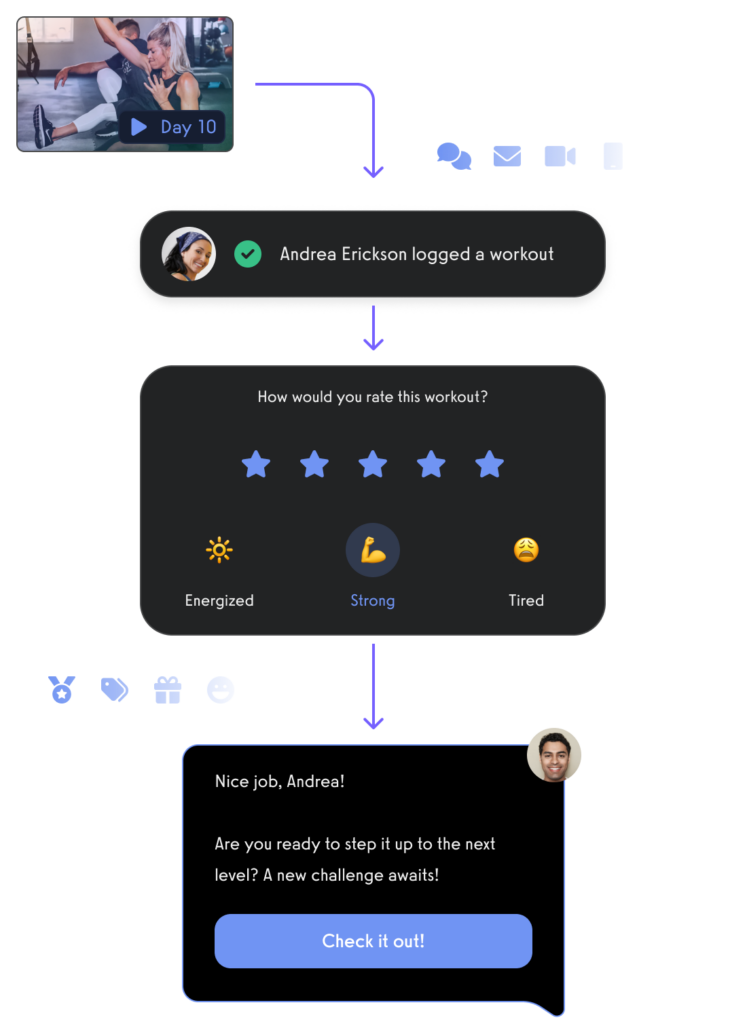
Manage leads with a fitness CRM.

Create and send fitness assessments with ease.
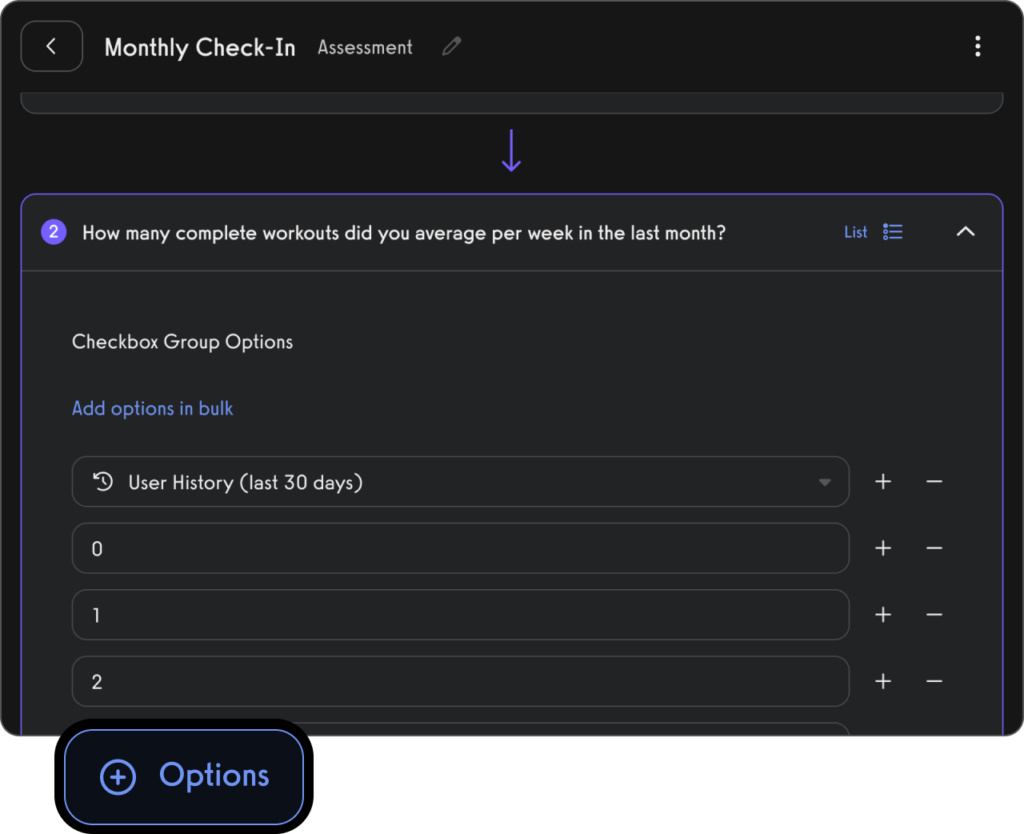
Use fitness habit tracking to inspire and motivate personal training clients (in-person and remote).

Use fitness progress photos to engage with clients.
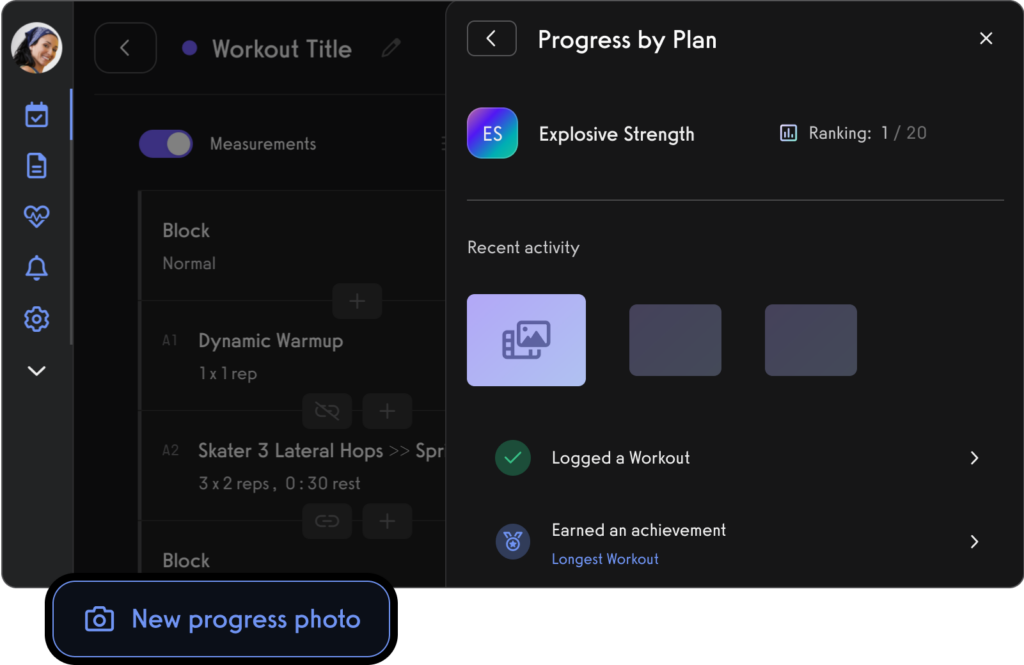
Use fitness leaderboards to track performance and inspire healthy competition.
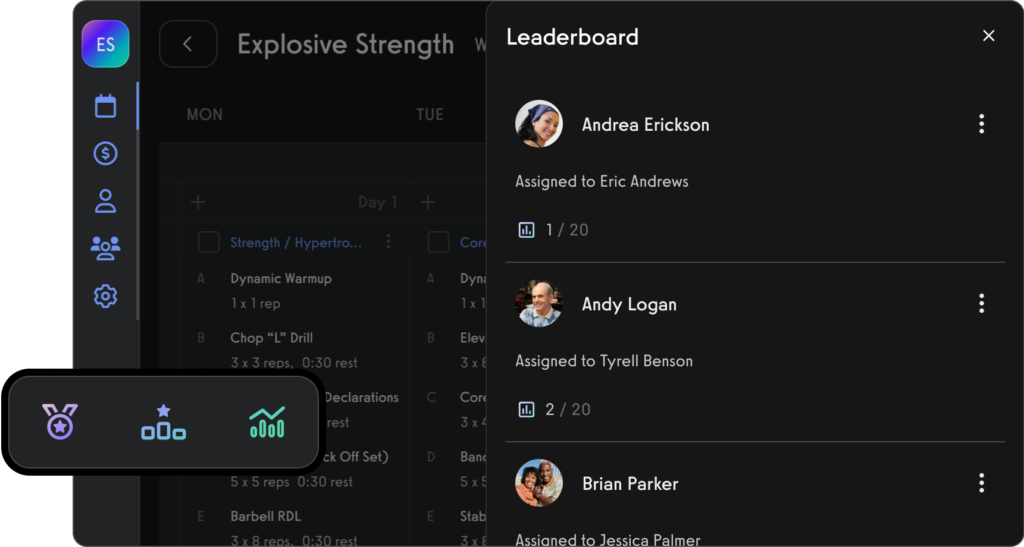
Use the exercise demonstration video library or create your own custom exercise demonstration videos.
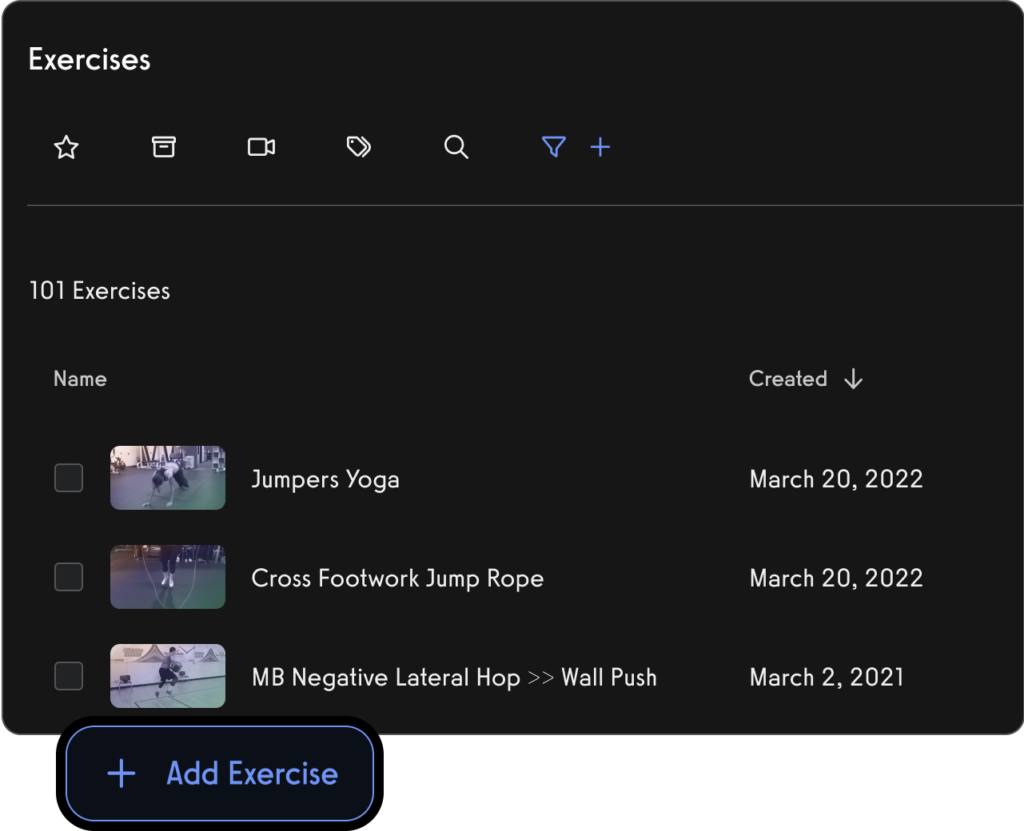
Create workout plans for parents and dependents, teams and more.

Manage personal training clients with ease.

Book appointments for clients (Read More: Best Gym Booking Software)

Create classes and fitness groups

Manage fitness challenges (Read More: 100+ Fitness Challenge Ideas)
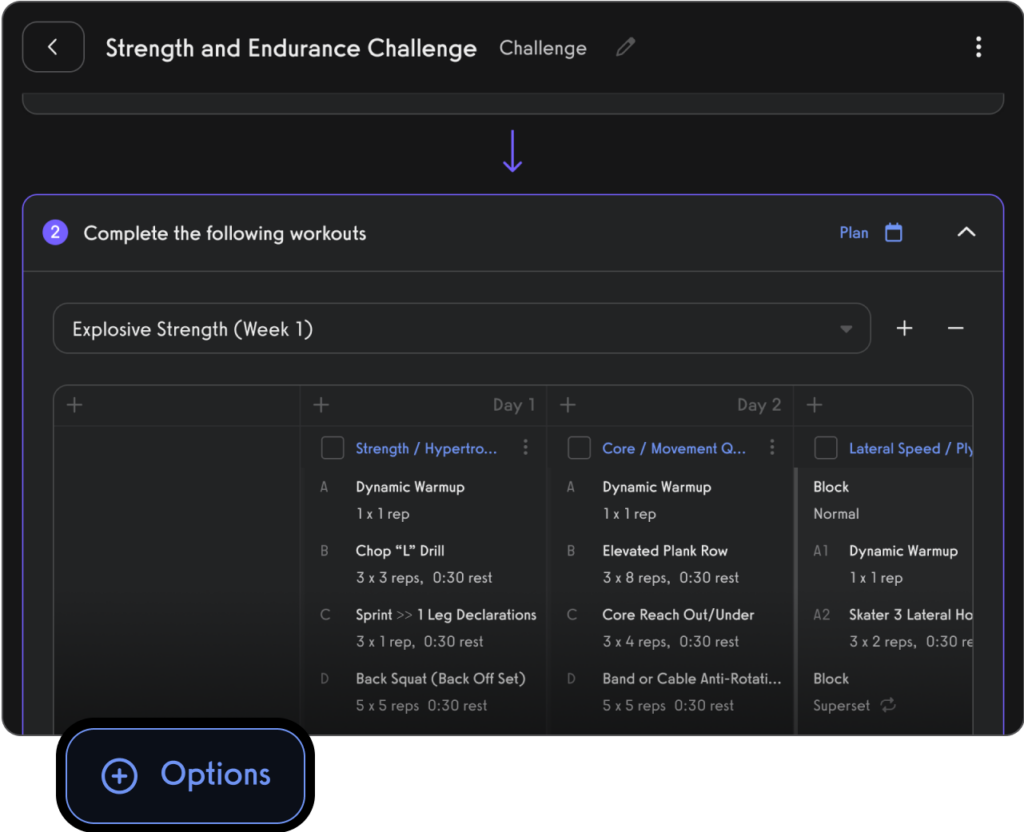
Process payments for open gym, classes, and personal training.

Communicate with gym members, athletes, team members, personal training clients, class members, parents, and dependents via SMS, email, and in-app push notification.
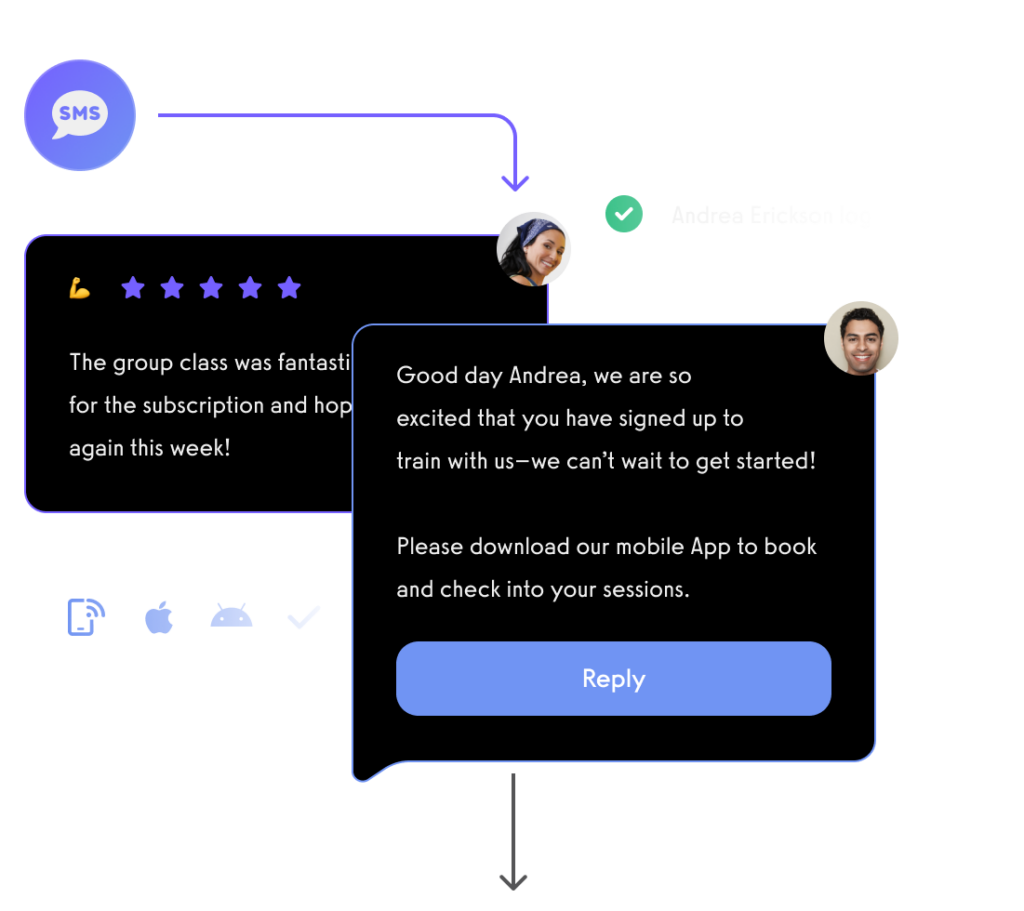
View performance over time, track personal records, and other fitness stats with performance reporting dashboards.

And of course, view all of your fitness business reports easily too.

All from your custom-branded fitness apps (Read More: Best Gym Mobile Fitness Apps Software)


Want to learn how your fitness business can take it to the next level? Get a demo now!
References:









